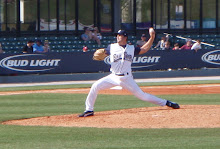From a general pitching stand point, I am a huge proponent of being on the attack at all times. As a general rule, we look for strike 1, strike 2, and strike 3 (or ball in play) in no more than four pitches. This technique leaves very little room for "toying" with the hitter. However, the idea behind the purpose pitch is to leave the hitter more vulnerable to a subsequent pitch that would ultimately put him away. Most purpose pitches are utilized when the pitcher is well ahead in the count (0-2, 1-2, or possibly if your command is really good that day, 2-2). For example, let's say the hitter is in a 1-2 hole and the last pitch you threw him was a good, hard fastball away that he fouled back. A pitcher's first instinct would usually be to go right for the punch out with an offspeed pitch down. However, many good hitters are looking for this and will be ready for it. Instead, you can do more to put yourself in the driver seat by purposefully elevating a fastball out of the zone. This serves two purposes. It changes the hitters eye level from low and away to up and possibly in. It also speeds up his timing as he takes a hard fastball that appears to be coming even faster because it is at eye level. With the count now at 2-2, we have more options than we did before to put the hitter away. Here, a good change-up that bounces on the plate (slightly away) or a breaking ball that starts at the hitter and breaks to the outside corner would leave the hitter helpless. Taking it a step further, a hard fastball away with good sinking action would likely entice the hitter to swing because he's been sped up and is looking hard, but won't be able to put good wood on a pitch that is well placed outside. The use of this type of purpose pitch is especially beneficial the second and third time through a team's lineup when it is beginning to feel as if you've gotten into a bit of routine. The hitter will sense this routine and the purpose pitch will undoubtedly throw him off.
Another great use of the purpose pitch is done in the reverse fashion of our first example. We are still ahead in the count (we'll say 0-2 here). If you are completely in the driver seat and want to go for the punch out. In this situation, we can go right for our best breaking ball that is only in the zone for a split second before darting down and away (usually into the dirt). At best, the hitter has expanded the zone so much that he flails at this pitch for an easy strike three. At worst, you've got him leaning on his front foot and very away that you will throw that breaking ball any where and any time. At his point (with the count 1-2) we can elevate a fastball, throw a better breaking ball, or paint a solid fastball on the inside corner for strike three. Again, the use of the other pitch was not to toy with the hitter. Instead, it was to leave him even more vulnerable to other pitchers later in the at bat and possibly later in the game.
Finally, hitters do tend to get a little territorial over that plate from time to time. As a pitcher, that plate (and both sides of it) is YOURS. Under no circumstances should you allow a hitter to dictate what side of the plate you want to throw to. If you see a hitter crowding the plate, scooting up in the box, looking at you the wrong way, looking at your girlfriend in the stands, showing up any of your teammates.....you let him know that you are running this game with a perfectly located fastball right beneath his chin. I am not saying to throw at him ... especially not at his head. Instead, a fastball about shoulder high and just inside of his body will have him spralling out of the way and dusting himself off. As the dust settles, give him nothing more than quick glance to make sure he knows you know what just happened. The purpose pitch here is designed to help dominate the game within the game. The mental game that is essential for a pitcher to dominate if he wants to be successful.
So we have our purpose pitches designed to put the hitter on the defensive in a variety of ways. Never be afraid to utilize them as you get more comfortable with the flow of each new game and the situations that call for them.
Until Next Time!!

And yet again, Forrest delivers in the clutch
ReplyDelete